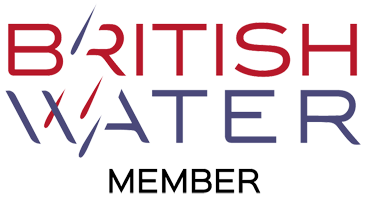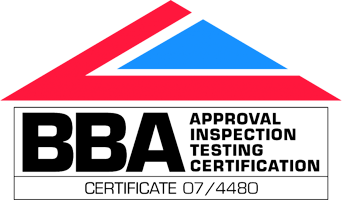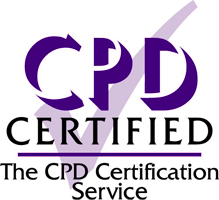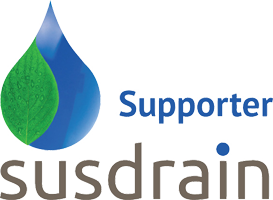Category Archives: Uncategorized
Recycled aggregate and below-ground SuDS
Recycled aggregate could be used more frequently for installation of below-ground attenuation assets, so gaining an understanding of the standards and best practice for this material is worthwhile.
Substituting recycled aggregate for virgin aggregate helps retain natural resources for future generations and can come with cost benefits. Although there is an opportunity to do this with below-ground attenuation assets in sustainable drainage systems (SuDS), contractors often choose to go with what they know – which is the ‘safe’ route of virgin aggregates.
In specifying recycled aggregates, designers and contractors should be aware of the relevant standards, together with any technical guidance from the manufacturer of the attenuation product. BS EN 13242 (+A1:2013) sets out the properties required for aggregates produced from natural, manufactured or recycled materials for hydraulically bound and unbound materials for civil engineering works. Reputable suppliers will provide recycled aggregate with a CE mark to demonstrate conformity to the standard.
Different product manufacturers may have additional requirements for recycled aggregate which is to be used in below- ground SuDS attenuation systems to ensure that it performs its intended functions. For instance, ADS Pipe’s technical guidance for recycled aggregate for its StormTech system calls for a 20/40mm aggregate which is clean, crushed and angular, with less than 5% fines. The reason for limiting fines is that the void space between the aggregate needs to be preserved to allow for the storage and movement of the water through the matrix of aggregate.
Specifications should set out an average porosity for the aggregate. Porosity is the volume of voids over the total volume; this is sometimes confused with void ratio which is the volume of voids over the volume of solids which can lead to installed systems not meeting design requirements.
Other factors to consider when selecting recycled aggregate include the nature of the ground and the groundwater and whether there are any potentially aggressive substances present. Sulphites carried in groundwater, for example, could react with recycled concrete aggregate and degrade it over time.
Different types of below-ground attenuation systems require different proportions of aggregate to manufactured product. Crates deploy small amounts of aggregate around their perimeter, large-diameter pipes and arch-shaped attenuation products use a greater proportion of aggregate.
With arch-shaped attenuation products, the aggregate around the arches has a dual purpose. It provides structural support, with the elliptical shape of the arches forming the aggregate around them into stone arches and structural columns, transferring the loads away from the chambers into the stiffer material surrounding them. The aggregate also provides additional storage volume which contributes to the efficiency of the attenuation system in terms of its water storage capability.
Recycled aggregate will not necessarily have lower embodied carbon than virgin aggregate, which tends to be supplied from quarries close to the point of installation. Recycled aggregate can come at a lower cost than its virgin counterpart, again depending largely on transportation distances.
Generally speaking, attenuation products requiring a higher aggregate-to-product ratio tend to have a lower overall carbon footprint per cubic metre of storage than those requiring less aggregate-to-product. • Stuart Crisp is UK manager at Advanced Drainage Systems (ADS)
Underground SuDS attenuation: avoiding failure
Stuart Crisp, UK manager of Advanced Drainage Systems (ADS), highlights the possible causes of failure that would-be asset owners should be aware of.

There’s a challenge with underground attenuation assets. By their very nature, they are buried. Given that third-party inspection during construction and post-construction surveys and snagging are not always undertaken, this can result in mistakes going unnoticed and a higher risk of failure.
As we anticipate the implementation of Schedule 3 of the Flood and Water Management Act 2010, which will mandate the use of SuDS for new developments in England and set up bodies to adopt them, this issue becomes ever more pertinent.
SuDS Approving Bodies (SABs) must be assured that they are minimising the adoption of avoidable liabilities along with the underground SuDS elements.
SABs should ensure that they know why design decisions were made, how products were chosen and whether they were re-specified by the contractor, how quality and technical checks were made and recorded, and the implications on performance, durability and maintenance throughout the asset’s service life.
Design
Designers should consider the performance and behaviour of an asset across its whole lifecycle including long-term and short-term loading, maintenance requirements, operation costs and end-of-life. To produce a robust specification for an underground attenuation device, they must understand how standards and guidance apply to structural performance, material behaviour, product design, manufacture and installation methodology, since all these factors contribute to the asset’s integrity and durability.
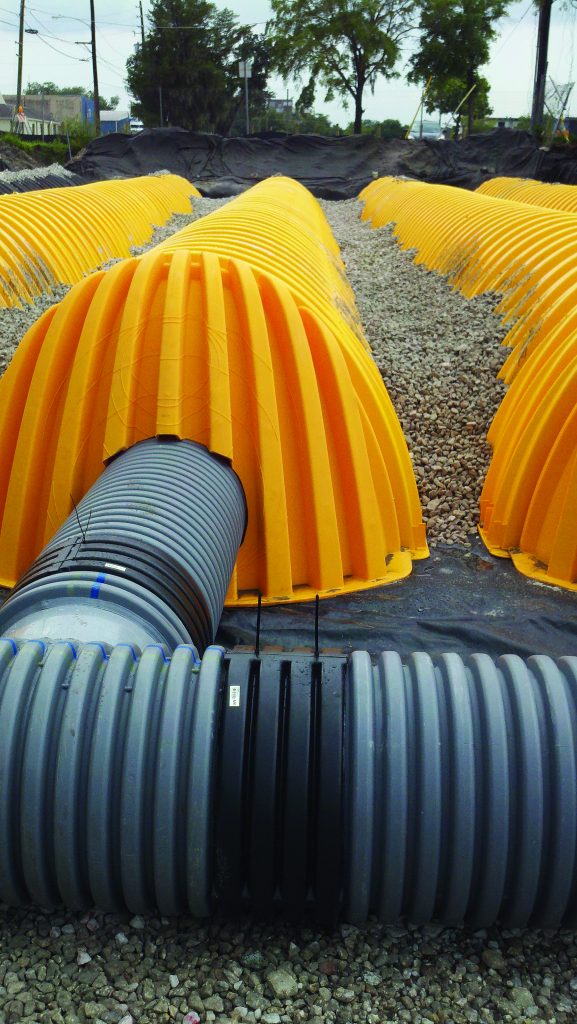
The SuDS system design must take into account the amount, concentration and types of pollutants to be expected in the storm water runoff and the respective treatment flow rates for the components used in the management train, as well as hydraulic flow rates. Failure to take maximum treatment flow rates into account can compromise the efficiency of the treatment device, and hence water quality passing through the system.
The design must also consider maintenance and inspection regimes, including cost, frequency, access for vehicles and the type of equipment that will be deployed.
Product selection
The decision on the type of underground SuDS attenuation may ultimately fall to an engineer, developer, contractor or even a sub-subcontractor. However, those making decisions about product choice may not have all the knowledge they need to understand the implications.
For instance, upstream sediment capture devices may be removed or down-sized because there isn’t a perceived risk of a high pollution load but if using a hard-to-clean attenuation system, such as many types of geocellular crates, that would mean that the size of the crate tank should be increased by 10% as its volume will reduce over time due to sediment build-up (ref CIRIA C753 The SuDS Manual clause 21.5.3 and table 21.2).
De-specification to choose cheaper products can increase the risks of failure. An alternative below-ground SuDS attenuation product may appear to perform in the same way, but adopting bodies and asset owners should check that they meet all the relevant standards and that they have undergone the appropriate certification and testing.
Installation
Poor workmanship can often be the reason for failure. An easy-to-install system saves time for the installer and reduces risk for the contractor and asset owner. Systems with multiple components and fixings require higher levels of skill and supervision and introduce more risk because time pressures, or parts missed-out during assembly, can lead to mistakes.
Connections and interfaces are important too. The ‘gut feel’ of how an operative thinks something should be installed may not match-up with what the designer and the manufacturer actually require.
Maintenance
The frequency and ease of maintenance of SuDS system will come under close scrutiny once SABs are preparing to adopt assets because these factors will influence the commuted sum that a developer must hand over on adoption of the asset.
In addition to an overall design that provides good access for vehicles and people, the design of the product is important. Asset owners must think about ease of cleaning sediment from the tank and any upstream treatment devices, and whether standard cleaning or specialist equipment is required.
Avoiding failure
Due diligence for any would-be asset owner must cover decisions made at all stages of the design and delivery of an underground SuDS attenuation device.
Failure to do this risks failure of the system through poor performance, or higher maintenance and repair costs than forecasted.
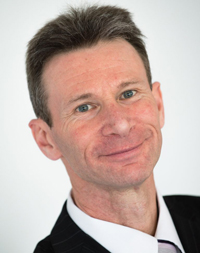
Stuart Crisp is UK Manager for Advanced Drainage Systems (ADS). ADS is America’s largest manufacturer of thermoplastic corrugated drainage pipes and a specialist in water management systems. StormTech has a long and successful track record with over 50,000 below ground SuDS attenuation system installations using in excess of 3m units.
Originally published in Water magazine October 2024
Underground SuDS attenuation: avoiding failure
Stuart Crisp, UK manager of Advanced Drainage Systems (ADS), highlights possible causes of failure in these important assets.
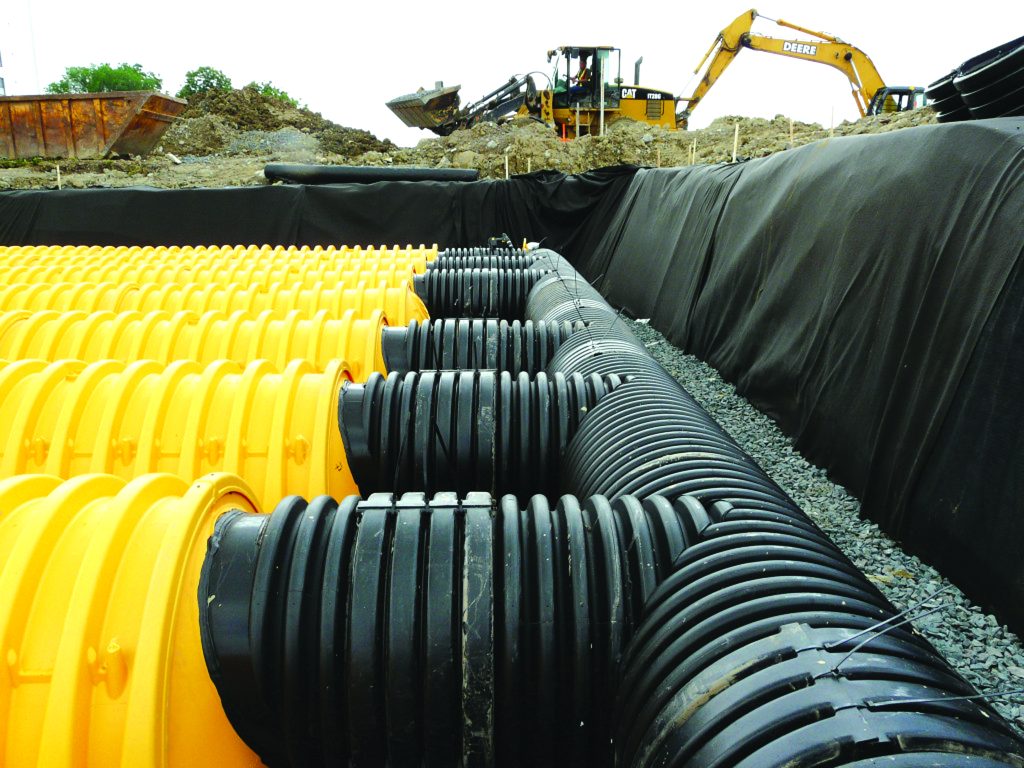
One of the challenges of underground attenuation assets is that, somewhat obviously, they are buried. Consequently, inspection during construction, post-construction surveys and snagging is not always undertaken which can result in mistakes going unnoticed and a risk of failure.
With the eventual implementation of Schedule 3 of the Flood and Water Management Act 2010, mandating the use and adoption of SuDS for new developments in England, this issue will become more pertinent.
Any SuDS asset owner and SuDS Approving Body (SAB) must be confident that they are minimising the adoption of liabilities with the underground SuDS elements. SABs should know why design decisions were made, how products were chosen (and whether swapped out by the contractor), the record of quality and technical checks made, and the implications for performance, durability and maintenance over the asset’s life.
Designers should consider the performance and behaviour of an asset across its lifecycle including short- and long-term loading, maintenance, operation costs and end-of-life. To produce a robust specification, they must understand how standards and guidance apply to structural performance, materials, product design, and manufacture and installation, since these factors contribute to the asset’s integrity and durability.
And those making decisions about product choice may not have all the knowledge they need to understand the implications.
Using a hard-to-clean attenuation system (geocellular crates can be an example), means that the size of the tank should be increased by 10%, as advised in CIRIA C753 The SuDS Manual. Without adequate upstream sediment capture, there can be an even greater risk that the tank’s storage volume will reduce over time due to sediment build-up.
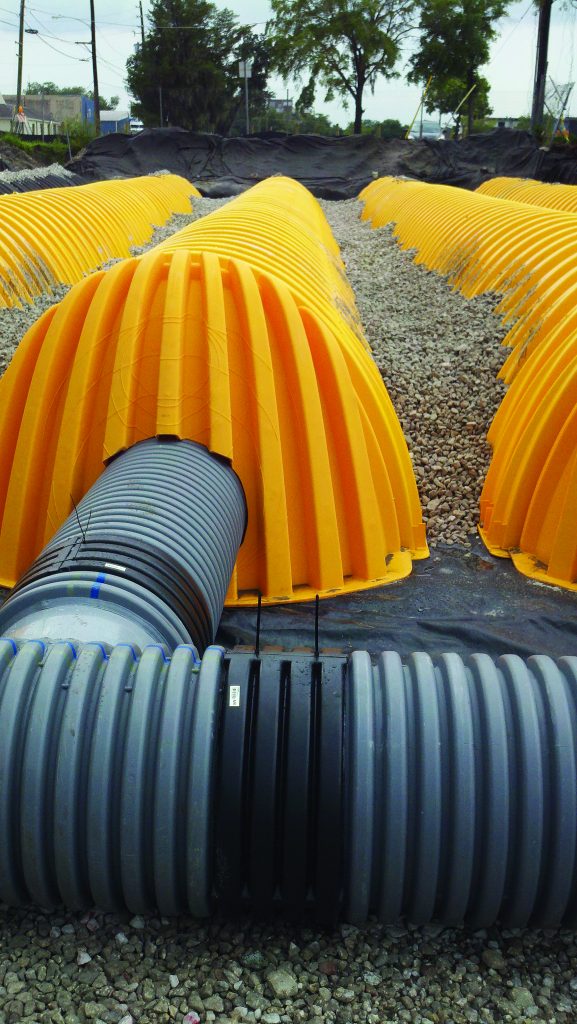
The system design must consider the amount, concentration and types of pollutants to be expected in the storm water runoff and the respective treatment flow rates for the components used in the management train, as well as hydraulic flow rates. The design must also embrace inspection and maintenance regimes.
‘Spec breaking’ to choose cheaper products can also increase the risks of failure. An alternative product may appear to perform in the same way, but it should be checked whether it meets all the relevant standards and has been certifiably tested.
Poor workmanship is often a reason for failure. While easy-to-install systems can save time and may reduce risk, systems with multiple components and fixings will obviously require higher levels of skill and supervision and introduce more risk.
The frequency and ease of maintenance of SuDS system will come under close scrutiny once SABs prepare to adopt assets because these factors will influence the commuted developer contributions handed over on asset adoption. Asset owners must think about access, ease of cleaning, the need for additional upstream treatment devices, and whether standard cleaning or specialist equipment is required.
Due diligence for any would-be asset owner must cover decisions made at all stages of the design and delivery of an underground SuDS attenuation device. Failure to do this risks failure of the system through poor performance, or higher maintenance and asset lifetime costs than anticipated.

Stuart Crisp is UK Manager for Advanced Drainage Systems (ADS). ADS is America’s largest manufacturer of thermoplastic corrugated drainage pipes and a specialist in water management systems. StormTech has a long and successful track record with over 50,000 below ground SuDS attenuation system installations using in excess of 3m units.
Originally published in NDE October 2024
SuDS: when grey is good
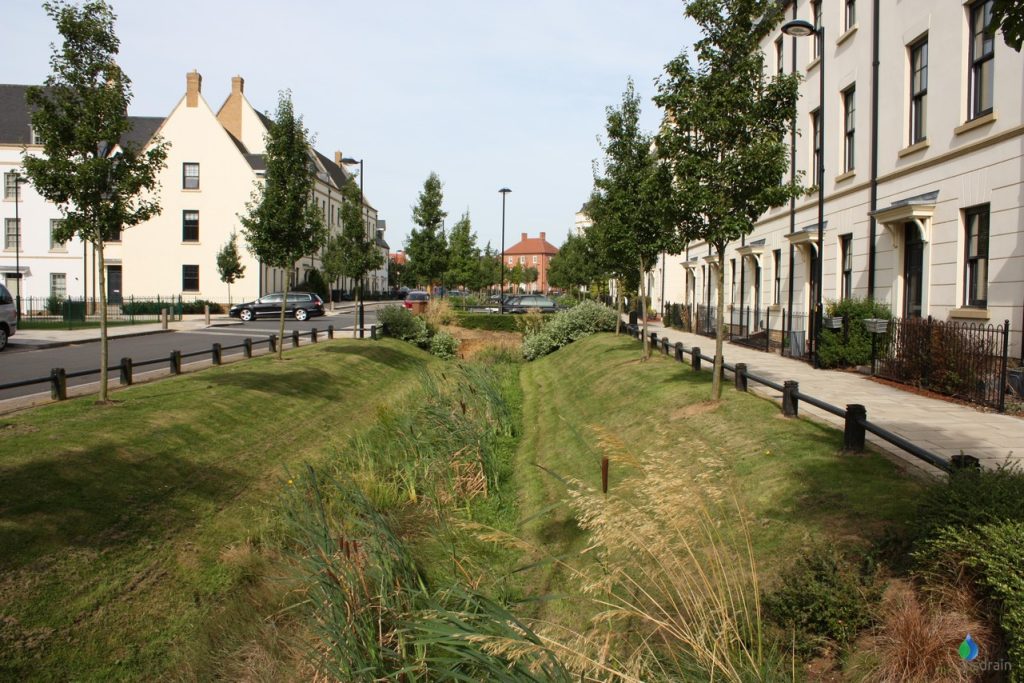
Under the new Government, cleaning up our water courses is a priority. That means that more robust approaches to treating polluted surface water, says Stuart Crisp, UK manager of Advanced Drainage Systems (ADS).
A major source of water pollution comes from surface water runoff from our towns, cities and highways. According to the Government’s Environmental Improvement Plan 2023, polluted surface water contributes to some 18% of water bodies failing to reach a status of ‘good’ under the Water Framework Directive. Meanwhile pollution from agriculture and rural land impacts on 40% of water bodies and pollution from wastewater on 36%.
The problem with surface water is that it is not being adequately treated before it flows into streams, rivers, ponds or lakes. In many cases, that is because no pollution treatment measures have been installed. In others, it is because elements designed to remove pollution are not being adequately inspected and maintained. And in some cases, it is down to inadequate or erroneous designs.
One serious issue is the mantra ‘green is good, grey is bad’ that underpins the policies and documents of many adopting bodies and asset owners when it comes to sustainable drainage systems (SuDS). The argument is that surface water should be controlled and managed at the surface, using vegetative solutions; ‘grey’ below-ground proprietary elements must be avoided at all costs.
However, the omission of grey SuDS infrastructure as a first defence in the treatment train, where there is a medium or high risk of pollutants in the surface water, can lead to contaminants entering vegetative SuDS components. In such situations, wildlife that has been attracted to settle there may be harmed by the presence of poisonous substances and polluted discharges may enter into water bodies downstream of the system.
The CIRIA SuDS Manual C753 provides a relatively simple method for dealing with such water pollution risks. For each type of pollutant, it sets out pollution hazard indices for a range of site types. The designer must then include SuDS components in the treatment train which have combined pollution mitigation indices equal to or exceeding the pollution hazard indices.
Where there is a risk of high pollutant loads it may be necessary to go beyond the simple index approach. For heavily trafficked roads, designers must use the process set out in the Design Manual for Roads and Bridges, although there are gaps in this guidance relating to the rainfall events, maximum treatment flow rates and treatment volumes that should be applied.
Treatment flow rates
When designing SuDS treatment trains for surface water pollution, it is important to appreciate the difference between hydraulic flow rates and treatment flow rates and the impact that they have on the design and each other.
The hydraulic flow rate is the volume of water that a system can handle within a certain timeframe which is determined with reference to the maximum event it must handle. The treatment flow rate is not the same. This is because most pollutants are contained in the ‘first flush’. The first flush is the initial runoff at the beginning of a rainfall event, which carries all the pollutants that have built up over a preceding dry period.
In longer lasting events, water that follows on after the first flush is likely to carry fewer pollutants because many of them have been washed away.
There are a variety of proprietary SuDS elements that can be used to remove sediment from the first flush of surface water; while there are also some SuDS elements – such as ADS’s StormTech arch-shaped system – which combine both treatment and water attenuation.
Those designing SuDS and those advising developers and adopting bodies need to develop a better understanding of how green and grey infrastructure can be deployed together to deliver the best possible results for water quality.
It is vital that SuDS designers appreciate the interplay of hydraulic flow rates and treatment flow rates and understand the types and amount of pollutant likely to arise within the runoff.
An appropriate water quality management strategy must be deployed to capture and treat the anticipated pollutants from the development, using a suitable combination of grey and green infrastructure. Failing to do so could lead to decreased treatment efficiency and harmful pollutants finding their way into the environment plus higher maintenance costs.
For more information on Advanced Drainage Systems, visit www.adspipe.co.uk.
